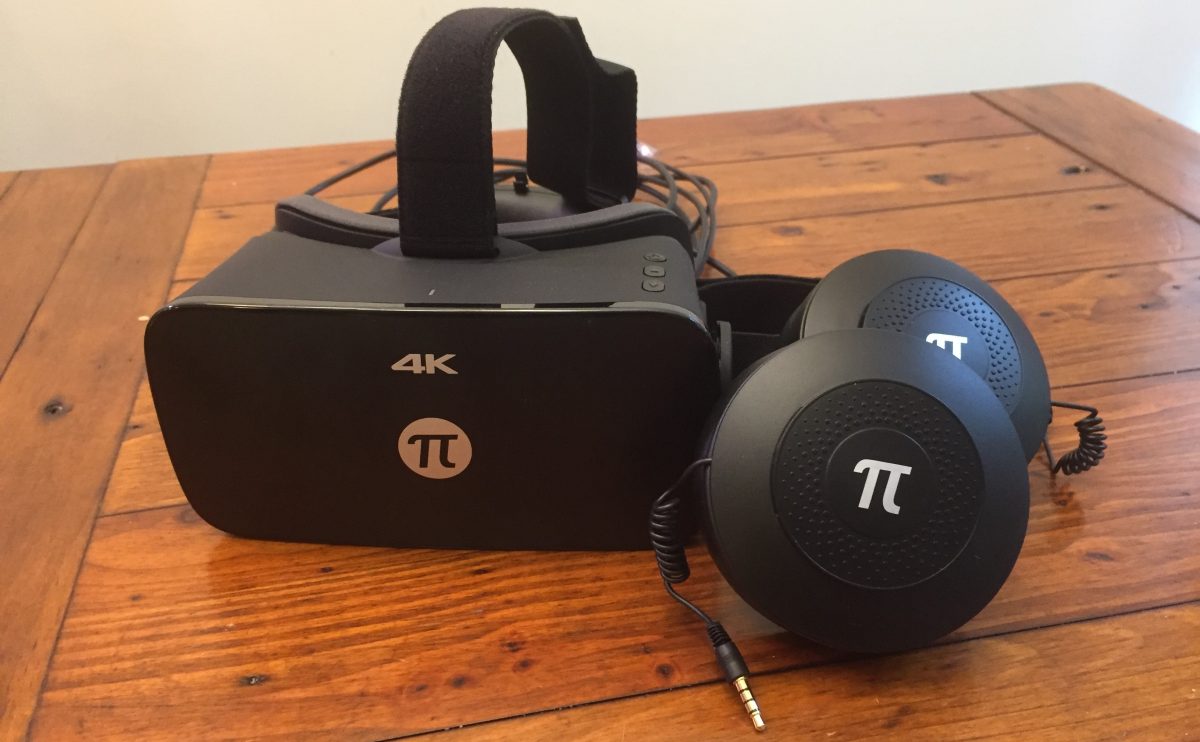 Virtual reality (VR) is the big thing in gaming these days, and there are a few options from which to choose when it comes to VR headsets and gear. You’ve likely heard of the two main PC VR brands that are currently dominating the market, as well as that one for a popular gaming console, however some more budget-friendly VR setups do exist. One such entry is the PIMAX 4K VR headset, and I was fortunate enough to have an opportunity to strap it on and jump inside.
Virtual reality (VR) is the big thing in gaming these days, and there are a few options from which to choose when it comes to VR headsets and gear. You’ve likely heard of the two main PC VR brands that are currently dominating the market, as well as that one for a popular gaming console, however some more budget-friendly VR setups do exist. One such entry is the PIMAX 4K VR headset, and I was fortunate enough to have an opportunity to strap it on and jump inside.
Virtual reality 101
Just in case you clicked on this review randomly and have no idea what all this “virtual reality” stuff is all about, let me give you the down ‘n dirty lowdown. Virtual reality, at its core, is an interactive computer-generated experience that takes place within a simulated environment. But it basically boils down to strapping something resembling a pair of ski goggles (or a big ViewMaster) on your face and getting the sensation you are actually “inside” a simulated game world. When it is done right, it is mind-boggling. The VR headset tracks your movements, so looking around while wearing it translates to looking around inside a game environment, or 360-degree video. The immersion is usually augmented by positional stereo sound through headphones.
PIMAX 4K VR out of the box
 As far as packaging goes, the PIMAX 4K VR is super bare bones. The whole thing comes in a cardboard box, that contains another cardboard box. Inside that cardboard box you’ll find the PIMAX4K headset snuggled in some grey foam, plus two (unattached) earphones, a lens-wiping cloth, and an instruction manual. Pretty no-frills, right?
As far as packaging goes, the PIMAX 4K VR is super bare bones. The whole thing comes in a cardboard box, that contains another cardboard box. Inside that cardboard box you’ll find the PIMAX4K headset snuggled in some grey foam, plus two (unattached) earphones, a lens-wiping cloth, and an instruction manual. Pretty no-frills, right?
PIMAX 4K VR Design
 In terms of design, the headset is made of black plastic and is quite lightweight. On top, there are two buttons for volume control, and a power button. The head straps are nylon with Velcro, and there is some nice comfortable padding on the back strap. The headset is fitted with spongy grey foam and fits comfortably. The two earphones are nicely padded for comfort and can be attached to the sides by slipping the side straps through some slots. You can then plug the earphones into the Pimax headset through 35mm jacks on the sides. Alternately, you can use your own headphones and forgo the extra weight of the included phones.
In terms of design, the headset is made of black plastic and is quite lightweight. On top, there are two buttons for volume control, and a power button. The head straps are nylon with Velcro, and there is some nice comfortable padding on the back strap. The headset is fitted with spongy grey foam and fits comfortably. The two earphones are nicely padded for comfort and can be attached to the sides by slipping the side straps through some slots. You can then plug the earphones into the Pimax headset through 35mm jacks on the sides. Alternately, you can use your own headphones and forgo the extra weight of the included phones.
Coming out of the headset is one cable that splits into a USB and HDMI connection. The cable is only about 6 feet long, so if you want to stand up, your computer will have to be close by. Overall, the build quality is quite good.
But wait. What about the base unit or cameras that track your head movement? Well, the PIMAX 4K VR headset doesn’t use those things, but rather a dual gyroscopic tracking system. So, the PIMAX headset works just like how your smartphone does, using an acceleration and movement sensor.
The other thing that’s missing is a controller, so you will only be able to use keyboard and mouse or your own gaming controller for any games you want to play.
Setting up the PIMAX 4K VR
 Ugh. Things kind of broke down for me when trying to set up the headset. A big problem is that no software is included with the headset. Instead, the manual directs you to the PIMAX website. Unfortunately, the Chinese company’s site seemed to be down. I tried again a few days later and I was still receiving the “bad gateway” message for their site. Undaunted, I took to the internet to search for a solution. I finally found the PIMAXforums, where they had posted a link to a third-party file-sharing site where the software could be found. That did not make me feel at all confident.
Ugh. Things kind of broke down for me when trying to set up the headset. A big problem is that no software is included with the headset. Instead, the manual directs you to the PIMAX website. Unfortunately, the Chinese company’s site seemed to be down. I tried again a few days later and I was still receiving the “bad gateway” message for their site. Undaunted, I took to the internet to search for a solution. I finally found the PIMAXforums, where they had posted a link to a third-party file-sharing site where the software could be found. That did not make me feel at all confident.
Nevertheless, I downloaded the software and installed it. It needed to update a couple of times, but then I was rewarded with the PiPlay homepage, where you can purchase games through Steam. I have read where you can also use the PIMAX 4K VR with Oculus Home, however it did not work for me, and other reviewers seemed to be experiencing the same issues. However, I did have some Steam VR games already in my Steam library, and the PiPlay software detected them, and enabled me to play them using the headset. Well, I did have to fiddle with the Steam settings to get it to recognize the PIMAX, but it was relatively painless.
How PIMAX 4K VR performs
 The real nitty gritty is how does this thing perform compared to other, more popular headsets on the market? I own one of the major PC VR headsets, as well as the console VR gear, so I have a pretty good frame of reference when it comes to graphics and lag for VR.
The real nitty gritty is how does this thing perform compared to other, more popular headsets on the market? I own one of the major PC VR headsets, as well as the console VR gear, so I have a pretty good frame of reference when it comes to graphics and lag for VR.
The PIMAX has a 4K screen (2K for each eye) but a slightly lower refresh rate than other headsets at 60 Hz. Apparently, the PIMAX makes up for the low refresh rate with some software acceleration wizardry, but that is a little beyond me. The dual 53mm lenses enable 110 degrees field-of-view (FOV), but the lack of tracking cameras means you won’t get room-scale VR out of these, really.
I will say that the tracking worked flawlessly. It was actually pretty surprising. I had doubts the gyroscopic tracking would be effective. I played Star Trek Bridge Crew, and the headtracking was spot on, with no discernable lag whatsoever. The quality of the graphics was amazing, too. The 4K really made things pop more, and things were very crisp, clear and bright. The included earphones worked well, too, delivering 3D audio and positional sound to further the VR immersion. I will admit the sound was a bit muted for my tastes, but the headphones do the intended job, and fit comfortably too, so no real complaints. Things were equally great looking for 360-degree videos I tested out.
No controller is a drag
Okay, I do have a complaint. The lack of any type of motion or hand controller is a real drag and becomes quite apparent when trying to play games that need such things. I usually use motion controllers when playing the Star Trek game, which greatly increases the immersion. With the PIMAX, I had to use a gaming controller to move my hands around, which really didn’t do it for me. I read that PIMAX are working on their own patented hand/motion controller, so stay tuned.
Getting the most out of your PIMAX VR
If you want to enjoy the PIMAX fully right now, then I’d make sure you have a game controller with your PC. I use a Logitech Gamepad F310 Controller, and it worked well with the games I tried out. You may also want to stick with games that have you sitting, or good 360-degree VR videos. I’d avoid FPS games for now, as it just isn’t the same immersive VR experience using a mouse and keyboard, or controller.
The Final word
The PIMAX 4K VR was a bit of a mixed bag for me. The headset is lightweight and comfortable to wear. It offers better graphics than the major brands, and accurate headtracking without the need for a base station or cameras of any type. However, the quirky install, lack of motion controller, and limited supported titles (ones without motion controllers) kind of take the wind out of the device’s sails. I think with the addition of the promised controllers, and a bit of tweaking to the software and compatibilities, and the PIMAX could be a heavy-hitting contender, thanks to the budget-friendly price. I’d definitely keep an eye on it, and don’t forget to check out all the virtual reality devices available online at Best Buy.




Hey I feel your frustration….
I can’t even spend the time to find where to complain about the treatment I am getting from BestBuy.
I will NEVER use this as source to shop again.
Comments are closed.